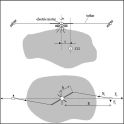Centrifugal Fragmentation of Asteroids

What would happen if we could use a spacecraft to increase an asteroid's spin rate? Asteroids made up of many small rocks loosely held together by their mutual gravitational force could be forced to break up as the centrifugal forces increased.
Background
In order to determine the composition and mineralogy of different asteroids, and to eventually mitagate their threat, ACT researchers came up with the idea of artificially increasing their spin rate up to a level where the stress induced by the centrifugal load induces fragmentation. Remote observation data supports the evidence that most sub-km asteroids, which tend to exhibit higher spin rate, are cohesive bodies held together by material strength while larger asteroids (km-size and more) may be loose gravitational aggregates. The ACT researcher Claudio Bombardelli proposed the use of a large tether to spin the asteroid and eventually induce its fragmentation, although the details of the design of a landing spacecraft that would perform such a task were not reviewed. Dr. Bombardelli's study concluded that "Further analysis should be focused on the mechanical behavior of the asteroid as its spin increases and on the outcome of the centrifugal fragmentation process.". It was apparent that this may be an interesting method to mitigate the threat posed by some Neart Earth Objects (NEOs). The question remains on what is the best strategy to artificially induce an asteroid fragmentation using centrifugal forces.
So, an Ariadna study started in 2007 with the aim of assessing the interest behind this novel idea. The objectives of the study were to carry out a literature review, to identify all relevant physical properties that need to be taken into account, to develop analytical and numerical models to accurately describe the centrifugally induced fragmentation dynamics of sub-km asteroids and to investigate the dynamical behaviour of accelerated asteroids.
Unexpected results
The study revealed more than was expected about asteroids made-up of small rocks loosely held together by their own gravitational force, the so called "rubble-piles". First of all, as shown in the videas below, the centrifugal force realigned the positions of the small rocks and changed the shape of the asteroid. This shape, as predicted by the models, is very close to that of some existing binary systems such as KW4.
Secondly, as expected, the rubble-pile breaks up as some of the small rocks have enough momentum to overcome the gravitational forces. Finally, we observe that some of the loose fragments recombine and form a binary system. These systems have also been observed although their formation due to this angular acceleration has never previously been suggested. All three phases can be clearly seen in the simulations below (note that we view the same asteroid from above and from the side and that the viewing is not in real time):
Simulation of the angular acceleration and fragmentation of a homogeneous rubble-pile
Simulation of the angular acceleration and fragmentation of a rubble-pile composed of two different rock types
Conclusions
The formation by angular acceleration of binary system asteroids with a shape similar to KW4 is new to science. The Observatoire de Nice, who cooperated with the ACT during this study, have since published a paper in Nature, explaining how natural spin-up is likely to be induced by the pressure of the Sun's radiation as asteroids approach it and distance themselves along their elliptical orbits.